Challenges in Implementing IoT for Enhanced Reliability and Effectiveness in Smart Grids: Literature Review
Abstract
Challenges in power quality and reliability present significant difficulties in conventional power grids for both service providers and customers. Smart grids (SGs) provide the opportunity to integrate renewable energy resources, and integrating Internet of Things (IoT) in the grid can enhance the capabilities of the SG. This provides solutions to various challenges in power generation and distribution. This article aims to discuss the challenges and solutions encountered during the implementation of IoT in SG by revising the authors and their ideas. In this review, numerous applications such as advanced metering infrastructure (AMI), data distribution service (DDS), and supervisory control and data acquisition (SCADA) and how they can improve reliability and effectiveness in SG were discussed. However, there are still challenges faced when using IoT in a SG, such as the security threats and storage of large amounts of data as well as the exchange of information between equipment and control systems. Therefore, future research should focus on new security protocols that are specifically designed to address the unique challenges of IoT in SGs.
1. Introduction
The power grid is a physical platform for achieving energy conversion and transmission as well as a key carrier for achieving several types of optimal resource allocation and fostering market competition. It is a crucial component of the infrastructure for economic and social growth [1–4]. The technical, economic, and integrated social advantages should all be considered when assessing the power grid’s special physical and social characteristics. Most nations have reached agreements on how the “smart grid” (SG) affects combating climate change, guaranteeing national energy security, and fostering green economic development [4–6].
1.1. Power Grid and SG
The conventional electric power system linked large power stations to a high-voltage transmission system, which then supplied energy directly to customers through a distribution system. The power stations primarily used fossil fuels and hydro turbines to generate electricity. The transmission system expanded from smaller regional grids into a vast interconnected network, which was managed using coordinated operating and planning procedures (Table 1). Energy consumption and peak demand increased at expected rates, while technology progressed within a structured operational and regulatory framework [1, 7]. An intelligent system that can consider the need of the zones and the availability of energy from the different sources in the areas is necessary without human intervention. SGs increase connectivity, automation, and coordination between these suppliers, consumers, and networks that perform long-distance transmission or local distribution tasks (Table 1) [8].
| Characteristics | Traditional power grid | Smart grid |
|---|---|---|
| Technology | Electromechanical | Digital |
| Distribution | One-way distribution | Two-way distribution |
| Generation | Centralized | Distributed |
| Sensors | Few sensors | Full of sensors |
| Monitoring | Manual | Self |
| Restoration | Manual | Self-healing |
| Equipment | Failure and blackout | Adaptive and islanding |
| Control | Limited | Pervasive |
| Customer choices | Limited | Many |
The ability of power consumption to be reduced during the peak hours, which is referred to as demand side management, is one of the advantages of a modernized electricity network; facilitating the connection of distributed energy sources—such as photovoltaic panels, small wind turbines, microhydroelectric systems, and combined heat and power units in buildings—to the distribution network, along with incorporating energy storage into the grid to balance generation loads and prevent disruptions such as the widespread cascading power failures shown in Figure 1. The increased efficiency and reliability of the SG reduces expenditure and CO2 emissions. More so, the involvement of the government is rapidly focusing on energy security terms, and investing in the SG might interestingly reduce dependence on nonhousehold energy sources.
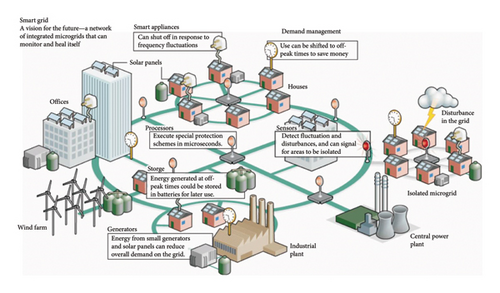
It can also enhance the grid’s resilience against military, whether physical or cyber in nature. The SG is also known by other terms, such as “Smart Electric Grid,” “Smart Power Grid,” “Intelli-Grid,” and “Future Grid” [1, 9–17].”
Internet of Things (IoT) is used for the generation, transmission, distribution, and consumption of power, among other SG components. The integration of IoT in the SG enhances the monitoring, control, and optimization of the entire power system. It enables a more responsive, efficient, and resilient grid, addressing challenges associated with reliability, sustainability, and overall performance. It has been employed for managing distributed power grids, such as renewable energy resources, and monitoring and maintaining energy consumption as well as production [18–21]. The use of IoT devices in the future SG infrastructure has several advantages that include increased power system dependability, enhanced supervisory control and data acquisition (SCADA) capabilities, improved network asset monitoring and management, and enhanced infrastructure for metering. Notably, the enabling of a real-time network that monitors IoT devices [22, 23] is one of the advantages offered by SG, integrating the current electricity grid with intelligent information systems based on the integration of quick and dependable communication.
The SG industry is confronted with a range of challenges in the form of IoT systems. Cloud services and other communication protocols are currently evolving standards in IoT systems as well as the security concerns related to device performance. More so, the transition to SGs requires a strong and secure wireless communication infrastructure. The IoT components of a SG are considered as the network’s vulnerable link because an attacker can compromise to gain access to the system and launch additional attacks [21].
In Figure 2, wide area network (WAN) is a system that can be a valuable tool to optimize the power generation and transmission on a SG. It uses sensors, communication networks, and other advanced technologies that allow for better management and optimization of the entire power system. By leveraging these technologies, a SG can achieve better situational awareness, improved response to dynamic conditions, and overall enhanced management of the power system. The implementation of WAN can help to monitor and control the power grid from a centralized location and allow for better management of energy usage. For example, renewable energy resources such as wind and solar energy resources generate power intermittently and make it difficult to predict the availability of energy. By using WAN, the power grid can be monitored in real time allowing for better management of renewable energy sources. This helps to ensure that renewable energy is utilized efficiently and effectively, reducing waste and maximizing the use of renewable energy sources [24–26].

Near area network (NAN) is another type of network that can be used in SG. While WAN is used for wide area monitoring and control, NAN is used for near area monitoring and control. NAN is typically used for monitoring and controlling devices that are located within a specific area such as a home or a building. NAN can be used for power distribution and for better management of energy usage within a specific area as shown in Figure 2. By using sensors, the power distribution system can be monitored in real time and allow for faster responses to any issues that arise. For example, NAN is used in electric vehicle (EV) charging. NAN can significantly contribute to the monitoring, control, and efficient use of energy in EV charging stations as these technologies play a vital role in creating a more intelligent and responsive charging infrastructure as part of the broader efforts to build smart and sustainable energy systems [26].
Home area network (HAN) is another type of network that can be used in SG. HAN is typically used for monitoring and controlling devices within a home or a building. HAN can be used for power presumption and allows a better management of energy usage within a specific area. For example, smart home appliances such as refrigerators and air conditioners can be equipped with IoT sensors, allowing for real-time monitoring. By utilizing HAN, these appliances can be controlled and optimized for energy usage and also help to reduce energy waste and improve the efficiency of energy usage [24, 26, 27].
2. Background
2.1. SG
The SG, known as the next-generation power grid, employs two-way communication of electricity and information to build an automated energy delivery network that is widely dispersed. Interestingly, three integrated parts are fully included, namely, power generation, transmission, and distribution [28, 29].
Modernizing the grid to implement the concept of a “SG” involves integrating advanced technologies and communication systems to enhance the efficiency, reliability, and sustainability of power generation, transmission, and distribution. Notably, a “digital upgrade” of the generation, distribution, and long-distance transmission networks is what is known as “SG,” and it aims to improve present operations by reducing losses and also opening up new markets for the production of alternative energy [8].
2.2. Power Generation
Power generation systems confront several difficulties in the face of climate change and a growing environmental consciousness. One major source of air and water pollution is the usage of fossil fuels, which is why the general public is becoming more and more against it [30]. The emission-free energy sources are those that are renewable (such as solar, wind, hydro, geothermal, and biomass). Technologies utilizing renewable energy resources are one of the best options since they can considerably increase global power output while emitting fewer greenhouse emissions [31–33].
2.3. Power Transmission Lines
Power transmission lines in a SG deliver the electricity from generation sources to end consumers to ensure supply power to the residential and industrial buildings. To meet the demand for real-time capability and reliability, the condition of the transmission line should be guaranteed to be more affordable. To utilize that, SG infrastructures including sensors require monitoring and detecting any fault in the power transmission lines during the delivery of the power. Additionally, monitoring the transmission line can enhance the security of power delivery by taking into consideration high efficiency and reliability. Infrastructures supporting communication and networking will be necessary for the smart transmission grid [13, 34].
2.4. Power Distribution
The topic of future distribution system design has received a lot of attention recently. The terms “SG” and “future distribution system” are used in this discussion. Regarding functionality, a SG should provide additional capabilities such as self-repair, robust reliability, efficient energy control, and instantaneous price adjustments. This is crucial due to the involvement of multiple parties in the process, and distribution has been lagging on some of these advances. The distribution of power has been incorporated with information and communication technology [35].
2.5. Energy Efficiency and Energy Storage
Currently, the growing energy consumption over the past few decades has increased operation costs in the electrical industry, which has resulted in the release of significant volumes of greenhouse gases into the atmosphere [36]. The SG is anticipated to boost the effectiveness of the existing electrical system, manage erratic power output based on renewable resources, lessen the need for fossil fuel-based energy sources, and ensure the stability of the power supply [37]. Additionally, battery energy storage systems (BESSs) can be utilized to boost a PV installation’s self-consumption and stack auxiliary services [38].
2.6. Integration in SG and Renewable Energy
The inclusion of renewable power generation units as emerging distributed generations covers a broad spectrum, ranging from large-scale units integrated into the transmission infrastructure to medium-scale units integrated into the distribution infrastructure as shown in Figure 3. Nevertheless, the deployment of small-scale units on commercial or residential buildings can pose challenges regarding dispatchability. The controllability of these resources is crucial both for managing their operation and for ensuring the smooth functioning of the electricity system [40].
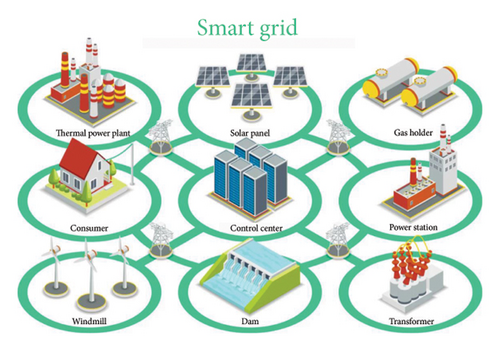
Advanced metering infrastructure (AMI) with high reliability: AMI is a key component in SG. AMI collects data, measures abnormality in SG, exchanges information between smart meters, monitors electricity quality and distributes energy, and analyzes user consumption patterns.
Smart house: A smart home may be used to communicate with users. Singapore improves their services to satisfy marketing demand, boost quality of service, manage smart appliances, read power consumption data acquired by smart meters, and keep an eye on renewable energy resources.
EV assistant management systems typically consist of an EV, a charging station, and a monitoring station that oversees the process. Users may search for the parking details and nearby charging stations using GPS, and the nearest available charging station will be immediately recommended by GPS. The monitoring center controls the management of automotive batteries, charging stations, and equipment.
Transmission line monitoring: To identify and fix fault concerns, wireless broadband communication technologies may be used to monitor the transmission lines [19].
3. Concept of the IoT
The term IoT describes a network comprising physical devices, vehicles, household appliances, and various objects equipped with sensors, software, and connectivity. This enables them to gather and share data among themselves [41–44]. It also refers to the network of interconnected devices and objects that communicate and exchange data with each other over the Internet. These devices, equipped with sensors, actuators, and communication modules, can collect, transmit, and receive data, enabling them to interact with their environment and other connected devices. IoT technology is used for various purposes across different industries. IoT has become increasingly popular in recent years due to its ability to connect devices and provide real-time data analysis as shown in Figure 4. This technology is used in various industries, including healthcare, transportation, manufacturing, and agriculture [45, 46].
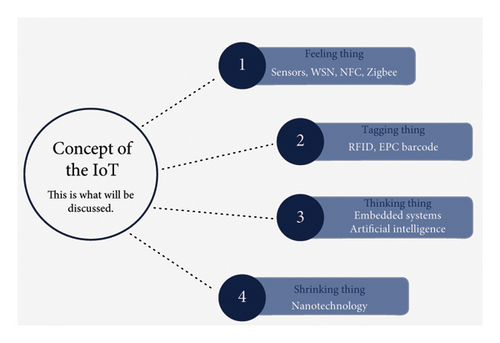
As summarized in Table 2, a survey on IoT awareness was conducted in Greece by a group of authors, namely, Papatsimouli et al. The survey was done to understand the level of IoT adoption and the factors that have influence over IoT [44]. Ray and Bagwari presented a paper on the security aspects and architecture of IoT-based smart homes [42]. Gnotthivongsa et al. presented a system to monitor home appliances in real time based on IoT technology, which improves safety and efficiency [43]. Xu et al. conducted a survey on the use of IoT technology in industries and its potential benefits in terms of efficiency, productivity, and cost savings [45]. Balaji et al. presented a survey on IoT technology, its applications, and the challenges associated with its adoption, such as security, privacy, and interoperability as shown in Table 2 [46].
| Author name | Date of publication | Field description |
|---|---|---|
| Md. O. Qays, et al. | Dec. 2023 | Key communication technologies, applications, protocols, and future guides for IoT-assisted smart grid systems: A review |
| G. F. Huseien and K. W. Shah | Jan. 2022 | A review on 5G technology for smart energy management and smart buildings in Singapore |
| G. Xu | Jun. 2022 | SG-PBFT: A secure and highly efficient distributed blockchain PBFT consensus algorithm for intelligent Internet of vehicles |
| M. A. Raza, M. M. et al. | Sep. 2022 | Challenges and potentials of implementing a smart grid for electric networks |
| J. J. Moreno Escobar, O. et al. | Jan. 2021 | A comprehensive review on smart grids’ challenges and opportunities |
| M. A. M. Sadeeq and S. Zeebaree | Apr. 2021 | Energy management for the Internet of Things via distributed systems |
| B. S. Murthy and S. K. Peddoju | May 2021 | IoT-based patient health monitoring, a comprehensive survey |
| M. Y. Mehmood | Jul. 2021 | Edge computing for IoT-enabled smart grid |
| M. A. Judge, A. Manzoor, et al. | Aug. 2021 | Secure transmission lines monitoring and efficient electricity management in ultra-reliable low latency industrial Internet of Things |
| O. Urbano | Feb. 2020 | Cost-effective implementation of a temperature traceability system based on smart RFID tags and IoT services |
| G. Dileep | Feb. 2020 | A survey on smart grid, technologies, and applications |
| A. K. Ray and A. Bagwari | Apr. 2020 | IoT-based smart home, security aspects, and security architecture |
| N. Gnotthivongsa, Huangdongjun, et al. | Apr. 2020 | Real-time corresponding and safety system to monitor home appliances based on the Internet of Things technology |
| H. Landaluce, L. Arjona, et al. | Apr. 2020 | A review of IoT sensing applications and challenges using RFID and wireless sensor networks |
| Q. Yang | Jan 2019 | Internet of Things application in smart grid: A brief overview of challenges, opportunities, and future trends |
| S. Hassan Mir | Feb. 2019 | Review on smart electric metering system based on GSM/IOT |
| A. Ghasempour | Mar. 2019 | Internet of Things in smart grid, architecture, applications, services, key technologies, and challenges. |
| K. Kimani, V. Oduol, and K. Langat | Jun. 2019 | Cyber security challenges for IoT-based smart grid networks |
| I. Worighi, A. Maach, et al. | Jun. 2019 | Integrating renewable energy in smart grid system, architecture, virtualization, and analysis |
3.1. Feeling Things
Feeling things can be applied to several areas of energy management, including energy consumption, transmission, distribution, and renewable energy sources [19, 47, 48]. By using sensors and other devices to collect data on energy usage, SG systems can adjust energy usage to meet the needs and preferences of occupants [19, 47, 48]. For example, if a room is unoccupied, the system can automatically adjust the temperature and lighting to save energy. Similarly, if a person prefers a certain lighting or temperature, the system can adjust accordingly to provide a more comfortable and personalized environment [19].
3.1.1. Efficiency on Transmission and Distribution
Sensors can be used to monitor energy flow and demand. The system can adjust energy production and distribution in real time, optimizing efficiency and reducing costs [19, 47, 48]. For example, the system can adjust energy production from renewable sources such as solar and wind power to optimize efficiency and reduce costs by analyzing weather patterns and other environmental factors [48].
3.1.2. Challenges of Using Sensors
Sensor challenges are often connected to their implementation which includes technical challenges, such as the need for interoperability between different devices and systems, the development of accurate and reliable sensors, and the integration of various data sources. More so, privacy and security concerns must be considered, as these devices collect and transmit sensitive data [19].
According to [47], M. A. M. Sadeeq, along with S. Zeebaree, in their study on energy management for IoT via distributed systems, proposed a distributed energy management system that optimizes energy usage in IoT devices. Ghasempour presented a paper on the architecture, applications, services, key technologies, and challenges of IoT in the SG. The paper also discussed the potential benefits of IoT technology in the SG as well as the challenges associated with its adoption [48]. Y. Perwej along with K. Haq, F. Parwej, and M. M [48] presented a paper on the IoT and its application domains. The paper provides an overview of IoT technology, its potential applications, and the challenges associated with its adoption.
3.2. Tagging Things
Tagging things are used to identify and track physical objects or assets in an IoT system [49–52]. Radio-frequency identification (RFID) tagging is a type of IoT technology that can be used in SG systems to improve energy management and efficiency [50, 52]. RFID tags are small, wireless devices that can be attached to objects, enabling them to be identified and tracked using radio waves [49–52].
3.2.1. Consumption and Production
RFID tagging can be used to track energy consumption and production, as well as to monitor and control energy usage [49, 50]. For example, RFID tags can be attached to smart meters, enabling utility companies to collect data on energy usage in real time. By analyzing these data, they can identify patterns in energy usage and adjust energy production and distribution to optimize efficiency and reduce costs [51]. RFID tagging can also be used to track renewable energy sources, such as solar panels. By attaching RFID tags to these devices, operators can monitor energy production and identify potential issues or inefficiencies [49, 50, 52].
3.2.2. Advantages of RFID Tag
One of the key benefits of RFID tagging is its ability to enable real-time data collection and analysis. By using RFID tags, energy usage and production data can be collected in real time, enabling grid operators to quickly detect and respond to changes in energy demand and supply [51]. This can lead to a more efficient and reliable energy system, as well as reduced costs and improved customer satisfaction [49–52].
3.2.3. Security of Energy Data
RFID tagging can help to ensure the security and privacy of energy data. By using encrypted RFID tags, data can be securely transmitted and stored which thus reduces the risk of data breaches and cyberattacks [51]. A study on smart inventory management systems based on IoT technology was presented by Paul et al. [49]. Their paper discussed the potential benefits of IoT technology in inventory management and proposed a system that uses RFID and wireless sensor networks. More so, Sarkar, along with Patel and Dave, presented a paper on the development of an integrated cloud-based IoT platform for asset management in elevated metro rail projects. The paper [51] discussed the potential benefits of IoT technology in asset management and proposed a cloud-based platform that uses IoT devices and sensors [52]. Landaluce, along with Arjona, Perallos, Falcone, Angulo, and Muralter, presented a review of IoT sensing applications and challenges using RFID and wireless sensor networks. The paper [53] discussed the potential benefits of IoT technology in sensing applications and proposed solutions to address the challenges associated with its adoption. The author [54] Urbano, with others, presented a paper on a cost-effective temperature traceability system based on smart RFID tags and IoT services. The paper discussed the potential benefits of IoT technology in temperature traceability and proposed a cost-effective system that uses smart RFID tags and IoT services.
3.3. Thinking Things
Thinking things use smart meters on the devices at home and business to measure energy usage and provide real-time feedback to both the consumer and the utility company. This allows users to monitor and control their energy usage, giving them a greater understanding of their consumption patterns and helping them make more informed decisions to reduce waste and lower their energy bills [53, 55]. Smart sensors installed on power lines can detect faults and outages in real time, allowing for immediate response and faster restoration of power [53, 55]. They can also be used to monitor the condition of equipment such as transformers and predict when maintenance is needed, thereby reducing downtime and improving reliability [53].
3.3.1. Control Renewable Energy
Smart sensors are used on renewable energy sources such as solar panels to monitor the output of these sources and adjust the grid accordingly to ensure a steady supply of energy [27, 54, 56, 57]. If there is excess energy being generated by solar panels during the day, this energy can be stored in batteries and later used to monitor and manage how electricity is consumed in homes [27, 56]. For example, smart thermostats can be programmed to adjust the temperature based on occupancy, reducing energy waste and saving money. Also, device scan can be used to control lighting and other appliances, turning them off when not in use and reducing overall energy consumption [27].
According to Hassan Mir’s review of smart electric metering systems based on GSM/IoT technology, the potential benefits of using IoT technology in electric metering systems were presented and a system that utilizes GSM and IoT for remote monitoring and control was also proposed [53]. Jakobi, along with Patil, presented a paper on privacy in smart metering from a user perspective. The paper discussed the privacy concerns associated with smart metering and proposed solutions to address these concerns [55]. Dileep conducted a survey on SG technologies and applications, exploring the potential advantages of SG technology and the hurdles linked with its implementation [27]. Meanwhile, Reddy, along with Kumar, Mallick, Sharon, and Lokeswaran, authored a paper presenting a review of integration, control, communication, and metering (ICCM) in renewable energy-based SGs. The paper discussed the potential benefits of ICCM and the challenges associated with its adoption [51]. Ramchurn, along with Vytelingum, Rogers, and Jennings, presented a paper on agent-based homeostatic control for green energy in the SG. The paper proposed an agent-based control system for managing energy consumption in the SG [57].
3.4. Shrinking Things
Shrinking things refer to the miniaturization of IoT devices that can be embedded in a wide range of objects, from sensors to appliances, and enable them to communicate and exchange data with other devices and systems [58–60].
3.4.1. Advantages of Shrinking
Shrinking things have several benefits for SGs with renewable energy. First, they have the tendency of making IoT devices smaller and more compact and can be integrated into a wider range of objects, including those with limited space, such as small appliances, vehicles, and even clothing [59, 59, 61, 61].
Second, the cost of IoT devices can be reduced by shrinking things, which may make them more accessible to a wider range of users and allow for greater adoption of SG technologies. This can help to accelerate the transition to renewable energy and reduce the carbon footprint of energy production [59, 61].
Third, accuracy and reliability of data collected by IoT devices can be improved by shrinking things since they can be embedded in objects near the source of the data. This ensures that data are collected in real time and are accurate, enabling utilities to make informed decisions about the management of the SG and the integration of renewable energy sources [59, 61].
Furthermore, Sánchez López et al. presented a paper on an architecture framework for smart object systems. The paper discussed the potential benefits of IoT technology in smart object systems and proposed an architecture framework to integrate IoT devices and sensors [58]. Harrison, along with Sánchez López, Ranasinghe, and McFarlane, contributed to the development of the architecture framework for smart object systems [58]. In the paper on the applications, investments, and challenges of IoT technology for enterprises, the authors contributed to the research on IoT technology and its potential applications in enterprises [59]. Bui, along with Castellani, Casari, and Zorzi, presented a paper on the Internet of Energy, a web-enabled SG system. The paper discussed the potential benefits of IoT technology in the SG and proposed a web-enabled SG system that uses IoT devices and sensors [61].
4. Characteristics of IoT
- 1.
Comprehensive sense: Deploying sensors can collect information from various sources, such as machines, structures, and the environment [4, 62–65].
- 2.
Intelligent processing: This information may be used to remotely monitor and modify the operation of systems and devices, including industrial machinery and smart appliances. This method makes it possible to control things efficiently and effectively such as thousands of solar panels no matter where they are [66–68].
- 3.
Reliable transmission: Utilizing these networks, it is possible to transfer data in real time, allowing for accurate and up-to-date information to be shared between devices and systems [19, 69, 70]. For more information on characteristics, see those papers [19, 67, 70].
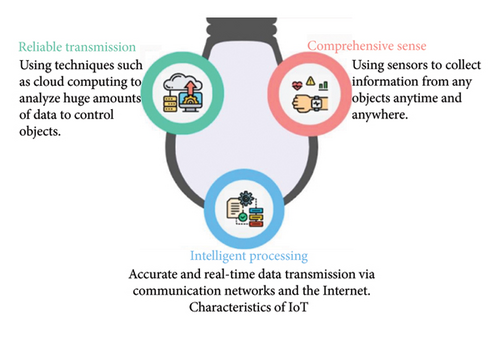
The authors [19] begin by describing the main characteristics of IoT, including connectivity, data, and automation, which allow IoT devices to communicate with each other, generate and collect large amounts of data, and perform tasks automatically without human intervention. They then discuss the impact of IoT on the development of SGs, highlighting the potential benefits of using IoT technologies to improve the efficiency and sustainability of energy systems. In addition, the authors [70] describe the characteristics of IoT, including connectivity, data, and automation, which enable IoT devices to communicate with each other, generate and collect large amounts of data, and perform tasks automatically without human intervention. They also discuss the potential impacts of IoT on the development of SGs, highlighting the potential benefits of using IoT technologies to improve the efficiency and sustainability of energy systems [71].
5. Applications, Benefits, and Limitations
5.1. AMI
AMI is a critical component of modern SGs. It facilitates two-way communication between utilities and customers. It includes smart meters, communication networks, and data management systems. In Figure 6, the implementation of AMI has several advantages such as enhanced energy efficiency, improved reliability, and outage management; it enhances customer engagement and operational efficiency [72]. Nonetheless, while AMI offers numerous benefits in terms of energy efficiency, reliability, customer engagement, and operational efficiency, it also presents challenges related to costs, privacy, security, and technology integration. Utilities must carefully weigh these factors when considering the deployment of AMI as part of their SG strategy [73].

5.2. Data Distribution Service (DDS)
DDS is a middleware protocol and API standard for data-centric connectivity from the Object Management Group (OMG). It enables scalable, real-time, dependable, high-performance, and interoperable data exchanges between systems [74]. In the context of SGs, DDS offers several benefits such as scalability and flexibility, real-time data handling, reliability and robustness, and security. However, it also presents challenges such as complexity, cost, resource intensity, and potential interoperability issues. Utilities must carefully evaluate these factors to determine the suitability of DDS for their specific SG needs [75].
5.3. SCADA
SCADA systems play a pivotal role in the management and operation of SGs [76]. They are essential for monitoring, controlling, and automating processes within the grid, contributing to improved efficiency, reliability, and flexibility. However, SCADA systems also come with certain drawbacks such as cybersecurity vulnerabilities, high costs, complexity, and dependency concerns. Utilities must carefully consider these factors when implementing and maintaining SCADA systems to ensure they maximize benefits while mitigating potential drawbacks [77].
5.4. Potential Security Threats and Mitigation Strategies for IoT-Enabled SGs
The advent of the IoT has improved the power grid, ushering in the era of SGs. However, the increasing interconnectivity and digitalization of the power infrastructure have also introduced notable cybersecurity challenges [78]. Identifying and addressing these threats is crucial for maintaining the reliability, efficiency, and resilience of SG systems. One of the potential security threats in IoT-enabled SGs is the vulnerability of communication networks [79]. IoT devices, such as smart meters and sensors, with the power grid create a complex, interdependent system that is susceptible to cyberattacks. They are often the weakest link as a result of shortcomings in computational resources and inadequate security measures [80]. The vulnerability of these devices is high to physical tampering, malware infections, or exploitation of weak authentication protocols. Thus, the IoT devices that connect communication networks in order to control centers are prone to attacks that include eavesdropping, man-in-the-middle attacks, and data interception [81]. These vulnerabilities can be taken advantage of to manipulate data, and disrupt communications, or even launch distributed denial of service (DDoS) attacks [82]. Additionally, vulnerabilities at the system level may arise from insufficient access controls, outdated software, or improper configuration of grid management systems. Weaknesses from these allow unauthorized access to critical systems which may lead to potential obstruction or data breaches [83]. As a result, strong encryption standards like Advanced Encryption Standard (AES) and Transport Layer Security (TLS) should be implemented across IoT devices and communication channels for significant protection of data integrity [84]. Secure communication protocols are essential for preventing unauthorized access to data, ensuring that interception and manipulation are avoided, which is crucial for upholding the grid’s reliability and overall security [85].
Blockchain technology adoption also is being utilized as IoT security integration with cybersecurity frameworks in SGs. It gives a decentralized, tamper-resistant ledger for transactions and authentication of devices as shown in Figure 7 [86]. This can help mitigate the risk of data tampering and unauthorized access. In a nutshell, vulnerabilities such as limited capacity systems, implicit trust, and the lack of robust authentication mechanisms can be exploited by malicious actors to disrupt grid operations, compromise data integrity, and even trigger cascading failures [87]. Another threat is known as advanced persistent threat (APT); herein, SGs are also targeted by APTs. These attackers have the tendency to have long-term access to the network and collect relevant data and manipulate grid operations secretly [88]. These threats are particularly as a result of their ability to evade detection for extended periods, causing significant disruption to grid operations and leading to potential outages [89].
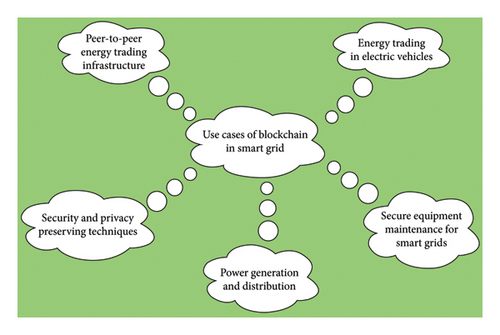
Interestingly, incorporating AI and machine learning (AI-driven threat detection) into these frameworks allows for real-time threat detection and response as they can analyze vast amounts of data to identify patterns indicative of APT security threats and respond more swiftly and accurately than traditional methods [90]. This is because even as traditional methods can be effective for threat detection, it can be limited in identifying new, unknown, or complex threats that have different patterns than the existing patterns [91]. In addition, Manipulation of Demand through IoT (MaDIoT) attacks is another potential threat to SGs. During this attack, IoT devices are manipulated to create demands that are artificial surges or reductions [92]. This can lead to blackouts or damage in equipment after it must have destabilized the grid. Attacks like this call for an importance of robust security measures at both the device and network levels. This also prompts to ensure that IoT security practices should comply with established industry standards such as NIST Cybersecurity Framework (NIST CSF) and ISO/IEC 27001 [93]. Conforming IoT security with these frameworks is crucial as it helps to maintain a consistent protection of critical infrastructure across the entire network [94].
Furthermore, the integration of IoT security into existing data governance policies ensures that all data, whether generated, transmitted, or stored by IoT devices, comply with relevant regulations, like GDPR, in order to protect user privacy and data integrity [95]. Overall, IoT security integration with existing cybersecurity frameworks is crucial for protecting SGs from the unique threats posed by IoT devices and networks [96]. Recent research and developments have presented several innovative solutions to address the evolving security challenges in SGs such as aforementioned blockchain technology and AI-driven threat detection [97]. Additionally, quantum-resistant cryptography, which is referred to as post-quantum cryptography, involves cryptographic algorithms designed to protect against potential threats posed by quantum computers [98]. In contrast to traditional computers that use bits as the smallest unit of information, quantum computers use qubits that can represent multiple states simultaneously due to quantum superposition. With the advent of quantum computing, traditional cryptographic methods may be outdated as researchers continue to develop quantum-resistant algorithms that can withstand attacks from quantum computers to ensure long-term security for SGs [99]. Zero trust architecture (ZTA): ZTA assumptions state that every network segment, device, and users could be compromised. It requires continuous verification and strict access controls to be effective in environments with a large number of IoT devices like SGs [100]. These recent solutions, when integrated with existing cybersecurity frameworks, can significantly enhance their resilience against both existing and emerging security threats [101]. More so, utilities can ensure the security, reliability, and resilience of IoT-enabled SGs when robust encryption, advanced threat detection, scalable data storage, and comprehensive incident response plans are implemented [102].
In addition, according to [103], utilizing cloud storage solutions can provide the scalability required to handle the massive data volumes generated by IoT devices as cloud storage offers flexible and on-demand resources, enabling efficient data storage and management. Reference [104] suggested that implementing distributed storage systems such as Hadoop and NoSQL databases can enhance scalability by distributing data across multiple nodes, ensuring high availability and fault tolerance. Utilizing machine learning algorithms for predictive analytics and anomaly detection can enhance the efficiency of data processing and provide valuable insights for grid management [105]. The use of big data analytics platforms can handle the large-scale data generated by IoT devices, enabling efficient processing and real-time analysis [106]. Notably, scalability and efficiency are critical challenges in data storage and exchange for IoT-based SGs. Addressing these challenges requires scalable storage solutions, optimized data transmission protocols, and advanced data analytics techniques [107]. By implementing these strategies, utilities can enhance the performance and reliability of IoT-enabled SGs, ensuring they can meet the growing demands of modern power systems [108].
Noteworthily, IoT has the potential to enhance the capabilities of technologies used in SG [109]. The extensive sensing and processing capabilities offered by the IoT can enhance various functions within the SG infrastructure, including processing, warning systems, self-healing mechanisms, disaster recovery protocols, and overall reliability [110]. The integration of IoT with SG has the potential to significantly propel the advancement of smart terminals, meters, sensors, information equipment, and communication devices utilized within the grid. By utilizing IoT, it is possible to achieve reliable data transmission in both wired and wireless communication infrastructures across various sections of the SG, including electricity generation, transmission lines, distribution, and consumption/utilization, as shown in Figure 8 [66, 111].
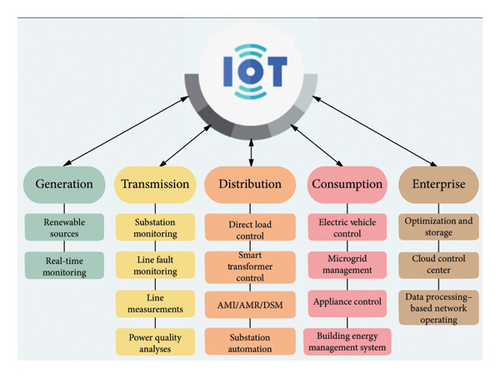
Currently, in this electricity generation, the IoT serves a multitude of purposes. It facilitates the monitoring of electricity generation across various types of power plants, including coal, wind, solar, and biomass facilities [112]. IoT enables tracking of gas emissions, management of energy storage systems, monitoring of energy consumption patterns, and prediction of the requisite power to meet consumer demand. Furthermore, IoT technologies can be leveraged to gather data on electricity consumption, aid in dispatching operations, monitor and safeguard transmission lines, substations, and towers, and manage and control equipment used within the electricity generation and distribution infrastructure [113]. To improve the reliability of transmission lines, wireless broadband communication technologies can be utilized for monitoring purposes. By deploying these technologies, it is possible to monitor transmission lines in real time, detect faults, and take corrective actions to eliminate them. On the customer side, IoT can be used in smart meters to track various parameters, support smarter energy use, enable communication between different networks, manage EV charging and discharging, and help improve energy efficiency and control power demand [114].
According to [115], a wide range of applications of IoT technology in various domains, including energy and power systems, were discussed. The potential advantages of using IoT technologies in the development of SGs, including enhancements in efficiency, reliability, and sustainability, were interestingly explored. The study provides a comprehensive overview of different aspects of SGs, such as electricity generation, transmission, distribution, and consumption/utilization, as shown in Figure 9 [116]. More so, the challenges that come with implementing IoT in SGs, such as ensuring data security and privacy, achieving standardization, and promoting interoperability, were also addressed [117]. IoT connectivity protocols can be categorized based on their key characteristics for various SG applications. For instance, the DDS protocol is suitable for controlling distributed systems, such as managing components of a smart wind farm, SCADA, and load balancing. On the other hand, the Message Queuing Telemetry Transport (MQTT) and Constrained Application Protocol (CoAP) protocols are more appropriate for data collection applications, such as gathering data from smart meters as shown in Figure 10 [118]. The Advanced Message Queuing Protocol (AMQP) protocol is commonly used for processing subscribers’ billing. Moreover, the Extensible Messaging and Presence Protocol (XMPP) and Representational State Transfer (REST) protocols are utilized in the Application Program Interfaces (APIs) of SG web-based programs, such as connecting with smart meters and remote controlling, for instance, lighting control [119]. The applications of each connectivity protocol in SG are illustrated in Figure 10.
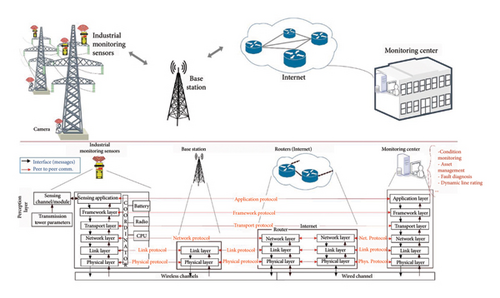
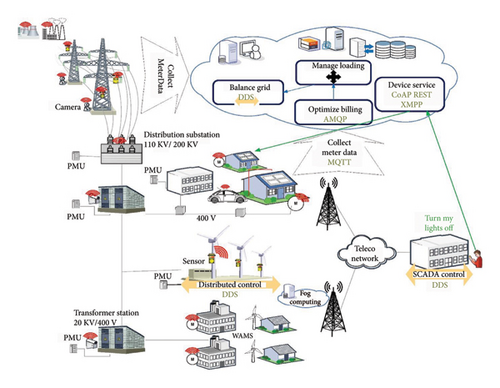
6. Conclusion
Ultimately, the importance of using IoT in SGs, the benefits and drawbacks of AMI, DDS, and SCADA, and the potential security threats, data privacy concerns, and vulnerability faced by IoT-enabled SGs were discussed in the current study. By utilizing IoT, the energy industry can shift from an organized and centralized supply chain to a more intelligent, optimized, and decentralized system. In this article, how the IoT is used in the energy industry generally and how it relates to SGs specifically were examined. Various IoT use cases in every stage of the energy supply chain were also categorized from generation through energy grids to end-use industries. The benefits of IoT-based energy management systems in boosting energy efficiency and incorporating renewable energy are discussed, and the results are summarized. Additionally, various IoT system components, such as enabling communication and sensor technologies regarding their use in the energy industry, were analyzed.
Noteworthily, cloud computing and data analytic platform tools that can be used for various smart energy applications, the challenges of implementing IoT in the energy sector, such as the difficulty of object identification, big data management, connectivity issues and uncertainty, integration of subsystems, and security and privacy, and the energy needs of IoT systems were discussed accordingly. Future research should focus on new security protocols that are specifically designed to address the unique challenges of IoT in SGs.
Consent
The authors grant the Journal to be publish the article.
Conflicts of Interest
The authors declare no conflicts of interest.
Funding
The authors extend their appreciation to the Deanship of Scientific Research at the King Faisal University, Alahsa, Saudi Arabia, for funding this research work through Grant No: KFU251517.
Acknowledgments
The authors extend their appreciation to the Deanship of Scientific Research at the King Faisal University, Alahsa, Saudi Arabia, for funding this research work through Grant No: KFU251517.
Open Research
Data Availability Statement
Data will be supplied by the authors if requested.




